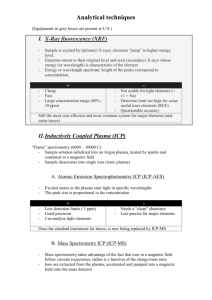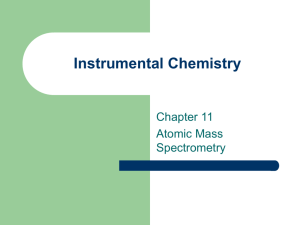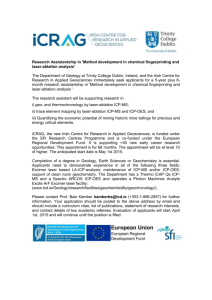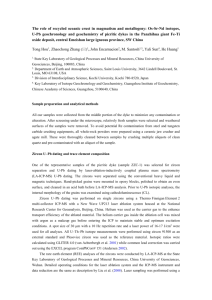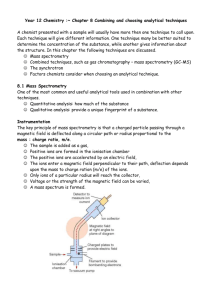CH915: Elemental Analysis
advertisement
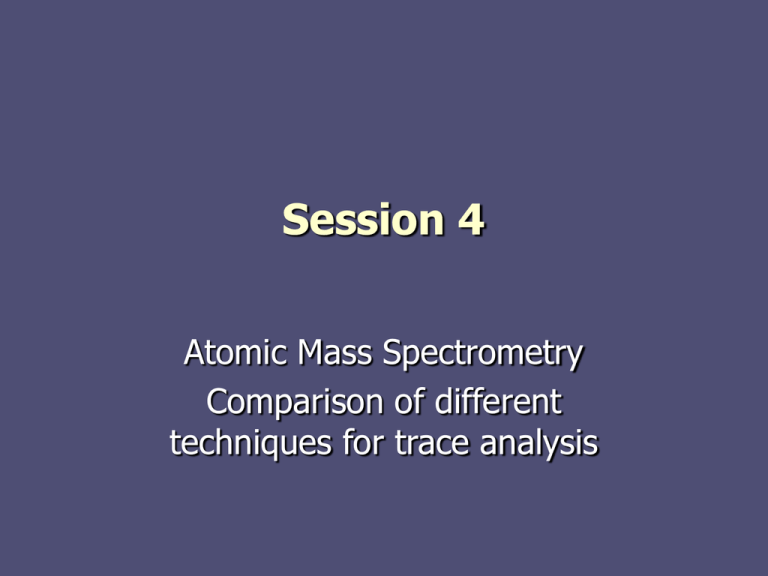
Session 4 Atomic Mass Spectrometry Comparison of different techniques for trace analysis Crucial steps in atomic spectroscopies and -metries and other methods Laser ablation etc. Solid/liquid sample Nebulisation Solution Sample preparation M+ X- Desolvation M+ Atoms in gas phase Ionisation MX(g) Vaporisation M(g) + X(g) Sputtering, etc. Molecules in gas phase Atomisation= Dissociation Excitation Ions ICP-MS and other MS methods (also: ICP-OES) Adapted from www.spectroscopynow.com (Gary Hieftje) Excited Atoms AAS and AES, X-ray methods ICP-MS Mass spectrometry method: detects ions distinguished by their mass-to-charge ratio (m/z value) Based on ions moving under influence of electrical or magnetic field Mass analysers generally require operation under vacuum, to avoid ions colliding with other particles Recommended series of short articles: Robert Thomas: A beginner’s guide to ICP-MS ICP-MS instrumentation and principle Plasma generates positive ions Under vacuum Detector (e.g. electron multiplier) nebuliser Interface Spray chamber Sorted by mass analyser, e.g. quadrupole, magnetic sector, according to m/z ratio sample http://www.cee.vt.edu/ewr/environmental/teach/smprimer/icpms/icpms.htm ICP-MS instrumentation Sampling cone Collision cell Detector (discrete dynode) ICP Torch Cones and Ion Optics Mass Analyser: Quadrupole Skimmer cone Modern instrument with collision/reaction cell 5 Recap: Ion formation in an inductively-coupled plasma Mostly, singly charged positive ions are generated (>90% efficiency) Interface and ion optics Room temperature, vacuum 6000 K, ambient pressure ICP torch Major challenge in instrumentation: large differences in temperature and pressure. Interface (consisting of two cones) allows connecting ion source to mass analyser (requires vacuum) Lens focuses ions. Necessary for getting as many ions as possible into analyser (maximising signal) Mass analysers for ICP-MS Quadrupole: High mass stability, fast Time-of-Flight (rare) HR (High-resolution): Uses magnetic sector mass analyser Lowest cost option Highest sensitivity and resolution, but slow and requires stable working environment Expensive Multi-collector (MD): Also with magnetic sector, but with detector array Good for accurate and precise isotope ratios Isotope dilution measurements – e.g. for accurate elemental ratios Quadrupole mass analyser Four parallel metal rods with dc and ac voltage (alternating with radiofrequency) Works as mass filter: allows passage of particular m/z ions only Can scan over m/z range spectrum Atomic mass spectra Ray and Hieftje, J. Anal. At. Spectrom., 2001, 16, 12061216 http://www.wcaslab.com/tech/ tbicpms.htm Typical detection limits of ICP-MS instrument http://las.perkinelmer.co.uk/content/TechnicalInfo/TCH_ICPMSThirtyMinuteGuide.pdf Multi-collector mass analyser Magnetic sector mass analyser separates ions according to m/z Simultaneous detection with array of collectors (Faraday cups) Best for detn. of isotope ratios Applications in geochemistry and biomedical research Possible factors that can affect the performance of ICP-MS Variations in plasma ionization efficiency Possible clogging or corrosion of cone apertures Differing concentrations of other components in matrix (e.g. acid, bulk elements) in samples could result in matrix suppression Ion current influenced by matrix composition Temperature and humidity fluctuations in the laboratory environment Isobaric elemental and polyatomic interferences: Used to be greatest limitation for applicability Polyatomic interferences in ICP-MS: Origins Spectral interference: caused by presence of species with same mass as analyte Often derived from compounds with Ar Analyte Interference 39K+ 38Ar1H+ 40Ca+ 40Ar+ 51V+ 35Cl16O+ 52Cr+ 40Ar12C+ 56Fe+ 40Ar16O+ 63Cu+ 23Na40Ar+ 75As+ 40Ar35Cl+ 80Se+ 40Ar + 2 Overcoming polyatomic interferences: Collision/reaction cells (CRC technology) Various modes of action: Collision-induced dissociation (less important) Chemical reaction (major mechanism) Requires reactive gas Electron transfer (major mechanism) KED: kinetic energy discrimination (monoatomic analyte and interfering molecules are retarded differently) Can either affect analyte or interference Commonly used gases: He, H2, ammonia http://breeze.thermo.com /collisioncells/ (Webinar) Polyatomics and high-resolution ICP-MS also no problem with polyatomics, as there are small, resolvable differences in mass: 31P 16O16O 14N16O1H 15N16O 30.95 31.00 Mass (u) 32S 31.95 32.00 Stable isotopes and their uses Most elements have more than one isotope E.g. 32S and 34S, or 56Fe and 57Fe Can use more than one mass for one element for measurements in ICP-MS IDSM: Isotope dilution mass spectrometry: Use particular isotope of desired analyte as internal standard in ICP-MS Can buy enriched compounds, e.g. 67ZnO, and use as “tracers” Example for use of stable isotopes • Metal-binding protein with 4 Zn(II) • Are all four zinc ions exchangeable ? • Isolated with natural abundance Zn(II): 60 % 50 40 67Zn: 30 4.1% 20 10 0 64 66 67 68 70 Isotope • Incubated overnight at 37°C with 40 mol equivalents of 67Zn(II) (93% isotopic purity) • Measured isotopic ratios Measurement and output (Thermofinnigan Element2) Total Zn and total S were determined using standard addition. For Zn quantification, the sum of the Zn isotopes 64, 66, 67, 68 and 70 was used. S was measured on the 32S isotope. Zn isotopic distribution (64, 66, 67, 68, 70) was determined. All elements and isotopes were measured in Medium Resolution (R = 4000). No internal standard has been used. No mass bias correction (using certified materials) was used for the isotopic distribution measurement. Sample preparation: Sample was diluted 1+49 with 18 MΩ water. For blank subtraction, the 10 mM NH4Acetate buffer was diluted 1+49 with 18 MΩ water. Results for sample: Total S 2.45 mg/L (± 0.2 %) Total Zn 2.21 mg/L (± 0.6 %) Ratios: 66Zn / 64Zn 0.657 ± 0.0028 (n = 7) 67Zn / 64Zn 4.17 ± 0.025 (n = 7) 68Zn / 64Zn 0.490 ± 0.0037 (n = 7) 70Zn / 64Zn 0.01325 ± 0.00007 (n = 7) S: Zn ratio: 9:4 (as expected; the protein contains 9 sulfurs) Comparison of experimental and calculated isotopic ratios 16 Calculated for 4 exchanging Zn(II) 14 12 10 As measured 8 6 Calculated for 3 exchanging Zn(II) 4 2 0 1 66/64 2 67/64 3 68/64 4 70/64 For each isotopic ratio, results agree best with the scenario for 3 exchanging zinc: Clear demonstration that only 3 out of 4 Zn exchange: The protein has one zinc that is inert towards exchange ICP-MS and hyphenation ICP-MS can be coupled with a variety of separation techniques: Liquid chromatography HPLC-ICP-MS Capillary electrophoresis CE-ICP-MS Advantages of hyphenated techniques: Laser ablation LA-ICP-MS better control over matrix Allows separation of different components: direct access to speciation For surface analysis For materials that are difficult to digest (e.g. alloys) Is being developed in scanning fashion with mm spatial resolution: Imaging the metal composition of a material Caveat: Calibration ? Laser ablation Useful for surface analysis of solid samples monitor camera Laser UV light Carrier gas in To ICP sample The ablation process Plume of molecules and ions from a surface hit by a laser http://kottan-labs.bgsu.edu/pictures/ Comparison: AAS, ICP-OES, and ICP-MS AAS: Single element, ppm/ppb range ICP-OES: Multi-element, ppb range Cheap, simple Small dynamic range GFAAS about 100 times more sensitive than FAAS, but also more challenging Limited spectral interferences, good stability, low matrix effects ICP-MS: Multi-element, possible to reach ppt (or even ppq) Most complex, most expensive, lowest detection limits, isotope analysis possible Comparison: Detection limits and working ranges http://pubs.acs.org/hotartcl/tcaw/99/oct/element.html Synopsis: Interferences in atomic spectroscopy Technique Type of Interference Ionization Flame Chemical AAS Physical Graphite Furnace AAS Physical and chemical Molecular absorption Spectral ICP-OES Spectral Matrix ICP-MS Spectral Matrix Method of Compensation Ionization buffers Releasing agent or nitrous oxide-acetylene flame Dilution, matrix matching, or method of additions Spectral Standard Temperature Platform Furnace (STPF), conditions, standard additions Zeeman or continuum source background correction Zeeman background correction Background correction or the use of alternate analytical lines Internal standardization Inter-element correction, use of alternate masses, higher resolution systems or reaction/collision cell technology Internal standardization http://pubs.acs.org/hotartcl/tcaw/99/oct/table1.html A technique decision matrix Exercise: How is this decision matrix correlated with strengths and limitations of the various techniques ? http://las.perkinelmer. com/content/relatedm aterials/brochures/bro _atomicspectroscopyte chniqueguide.pdf Other inorganic mass spectrometry methods Mainly for surface analysis (depth profiling, imaging) in different materials (e.g. conducting, semiconducting, and nonconducting solid samples; technical, environmental, biological, and geological samples) Spark source mass spectrometry (SSMS) Glow discharge mass spectrometry (GDMS) Laser ionization mass spectrometry (LIMS) Thermal ionization mass spectrometry (TIMS) Secondary ion mass spectrometry (SIMS): most sensitive elemental and isotopic surface analysis technique Sputtered neutral mass spectrometry (SNMS) Detection limits for the direct analysis of solid samples by inorganic solid mass spectrometry: down to ppb levels SIMS: secondary ion mass spectrometry One of the most widespread surface analysis techniques for advanced material research Principle: bombard surface with ions, “secondary” ions are sputtered from surface High sensitivity for all elements Any type of material that can stay under vacuum (insulators, semiconductors, metals) Potential for high-resolution imaging (down to 40 nm) Very low background: high dynamic range (more than 5 decades) Quantitative work complicated by variations in secondary ion yields in dependence on chemical environment and the sputtering conditions (ion, energy, angle) Rapid deterioration of bombarded surface Static SIMS: Molecular and elemental characterisation of top monolayer • Dynamic SIMS: Bulk composition or depth distribution of trace elements. Depth resolution ranging from one to 20-30 nm
